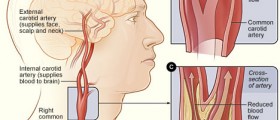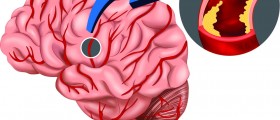Sensations of numbness (and of intense pain) on the upper left quadrant of the abdomen below the stomach can be caused by a number of medical conditions that are relatively common, but seldom discussed. If you experience this type of numbness, you may want to know what the possible cause is before you feel comfortable with seeking medical attention.

Let's start with problems that are relatively common, but found in older people, and progress to problems that are less common, but found in younger people.
- Ischemic colitis on the left side of the abdomen can be caused by a blood clot, an atherosclerotic "clog" of calcified cholesterol, or generally poor blood circulation through a blood vessel known as the inferior mesenteric artery. By age 80, about 20 percent of people no longer have circulation through this artery, but the body develops collateral circulation to get blood where it is needed in the colon. A sudden shut-down of this artery can be rapidly fatal. Ischemic colitis is most common in (1) older people who aren't physically active and (2) younger people, even in their twenties and thirties, who become dehydrated during an athletic event. It's the younger people who are more likely to die of the disease. Numbness in this location may be a sign that the artery is not functioning well, but the colon is still getting enough blood supply to function.
- Gastroparesis is a medical condition in which the vagus nerve has been damaged (usually by uncontrolled diabetes, but the damage may also be done by an autoimmune disease) and no longer sends signals to the stomach and duodenum (the first part of the small intestine, nearest to the stomach) to pass food downward. When this is the problem, there is usually a lack of appetite. Just eat a few bites of food, and you are no longer hungry, because your stomach is still full.
- High-fat and "chunky" diets can slow down the digestion and passage of food so much that digestive stasis results. When food is not completely chewed, the stomach needs more time to break it down. Fat has to be emulsified, and stays in the stomach and small intestine longer, sometimes long enough it seems that nothing is moving at all.
- C-sections are also associated with loss of sensation around the incision area, including deeper within the abdomen, as a result of nerve damage. Surgery and massage can sometimes help to repair the problem.
- Finally, neuropathy can cause paresthesias, losses of sensation, in odd combinations of locations in the body, for instance, numbness in the pinkie finger and numbness underneath the stomach can be caused by neuropathy. Again, the most common cause of neuropathy is uncontrolled blood sugar levels in people who have diabetes, but there are drugs and other diseases that can result in loss of sensation as well.
When is numbness on the left side of the stomach a reason to see a doctor?
- If the numbness you are experiencing is followed by unbearable pressure pain, get to an emergency room right away or call an ambulance. This is one of the key symptoms of ischemic colitis, which can be fatal if not treated promptly. Call for an ambulance or have a friend or relative drive you to the ER.
- If you don't feel like eating, and you are severely constipated, see a doctor urgently (although it is not usually necessary to call an ambulance).
- If your sole symptom is numbness underneath your stomach, see if changing your diet may help to alleviate the problem. Some foods are frequently associated with this phenomenon, namely fried chicken, pizza, cold cuts, bacon, barbecue, and sausage, and, in many people, coffee, lettuce, onions, and salsa. Other foods usually relieve it, including crackers, ginger ale, seltzer and mineral water, tea, sweet potatoes, white potatoes, white (but not brown) rice, fish, and soup. High fiber usually makes the problem worse, not better.
- Numbness can be a symptom a number of diseases, including the previously mentioned diabetes, but also amyloidosis, hypothyroidism, porphyria, chronic hepatitis, uremia, and polycythemia. When the problem is diabetes, the symptoms tend to be asymmetric, for example, numbness on the left side of the stomach, but not the right, a tendency to trip with the left foot but not the right, numbness in a finger or fingers on the left hand, but not the right, and so on.
- Greene DA, Stevens MJ, Feldman EL. Diabetic neuropathy: scope of the syndrome. Am J Med. 1999 Aug 30. 107(2B):2S-8S.
- Photo courtesy of SteadyHealth
















